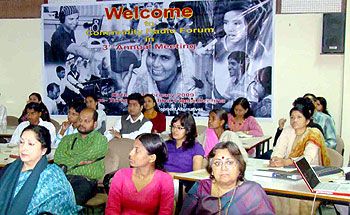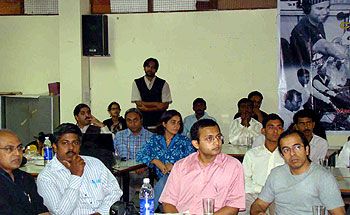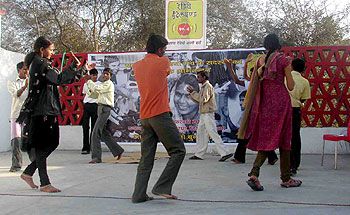




MUMBAI: The third annual meet of the Community Radio Forum was organised on 14 February at Radio Bundelkhand, Orchha. Resolutions regarding forming a consortium for approaching advertisers, relocating the secretariat for Community Radio Forum, reserving 4 MHz of frequency for CRs and lifting the current ban on news were suggested during the meet.
The earlier meetings have been held in Delhi in 2007 and in Bangalore in 2008. The Orccha meet was attended by representatives of community radio initiatives in the country, including the Kutch based Radio Ujjas, Radio Kumaunvaani, Uttarkhand based Henvalvani, Radio Dhadkan, Gurgaon based The Restoring Force, radio initiative by IGNOU etc, and hosted by Radio Bundelkhand.
Community Radio Forum is a registered body under the Societies Act officially registered on 26 February 2008. The forum facilitates better interface between the government and communities, funding agencies, and other broadcast media, and also helps communities /organizations to set up and operate their own Community Radio Station.
Some of the key activities of the CRF are in the areas of policy reforms and advocacy, documentation, monitoring and evaluation of CR Initiatives, awareness building conferences, capacity building, technology options, setting up a help desk, fund raising etc.
The annual meet addressed many issues including that the secretariat and the national convener of CRF which was Drishti Media, Arts & Human Rights to be relocated and CRF is in the process of shifting their secretariat. It was also resolved to make CRF a pan India organisation and the core team to include representatives from as many states as possible. For expanding the CRF network across states, membership forms were floated during the meet where the communities could opt for institutional or individual memberships. The annual subscription fees for both the categories includes- Rs 1000 for institutional membership and Rs 300 for individual ones.
The current status of community radio in India includes approximately 141 NGO applicants with the Information and Broadcasting Ministry of which 40 may have received Letters of Intent. The operational ones include 36 campus-stations and three operational NGO-led CR stations - MVSS led station at Satara, Bundelkhand Radio at Orchha and the Deccan Development Society DDS community radio station at Pastapur, Andhra Pradesh.
The third annual meet of the CRF held at Radio Bundelkhand was a great opportunity for communities to meet and discuss potentials and problems/issues, which may be faced by them in setting up their own Community Radio Station.
The key discussions in the meeting revolved around technological, procedures, advocacy and financial stability issues. One of the main challenges of the community radio is technology, non availability or scarcity of transmission systems and archiving of content among others. The issues were tackled by Gram-Vaani, an initiative by five youngsters involved in building technologies and businesses for community media in the rural areas of India. Gram-Vaani is working in the areas of PC-based community radio systems that are one-tenth the cost of commercial FM solutions. To provide extremely low-cost wireless Internet connectivity for community radio stations and village kiosks and information portal to enable governments, NGOs, community radio stations, and development experts to interact with each other.
There was an open house discussion on setting up of a community radio and Indra Mansingh from Radio Bundelkhand stated, The capital cost for setting our station amounted to 8-9 lacs and the training cost was around 1,10,000 which was funded by UNESCO. A sum of Rs 40,000 was paid twice towards spectrum fees and 20-30,000 for licensing procedure. Apart from these one time cost, the operational cost varies from 40-45,000 per month in addition to some unexpected expenses every month.... Community radio stations are supposed to pay spectrum fees starting from the quarter of frequency allocation.
Talking about the cost of setting up transmitters, Hemant Babu of Nomad India Network said, The cost of mono transmitter varies from Rs 25,000 to Rs 1, 40,000 and transmitters with 50-100 watts cost around Rs 80,000 – Rs 1,00,000 but small transmitters reaching out 4-5 kms with 30-50 watts is apt for community radios. Of primary importance, is handling of transmitters, cable, antenna and maintaining the temperature after being set up. If properly maintained, transmitters could work for 25 years or more....
Sustainability and financial stability is an important issue for all the community radio stations which are operational and the lined ones. It was proposed that community radio forum should form a consortium to approach advertising agencies and government agencies and negotiate advertising rates for community radios. AMARC President (World Association of Community Radio Broadcasters) – Asia Pacific Region Ashish Sen explained, We need to take lessons from other countries and should build up a team to negotiate with advertising agencies and have regional representatives in the consortium.... Business houses are in a look out for marketing options and rural penetrations and if community radios offer a sizeable chunk, advertisers would be interested. Several government departments are willing to spend at grassroot level and are looking for single agencies who will ensure value for their money. It was also proposed that backing of a listenership survey could place the CRs in a better negotiating position.
CRF expressed their concern on the availability of frequencies for community radios. With many campus radios being granted licenses and the third phase of licensing for private commercial FM stations lined up, there would be a scarcity of frequencies for community radio. It was suggested that 4 MHz of frequency should be reserved for community radio. Apart from the procedural, advocacy, technical issues it was also proposed that ban on news should be lifted from community radio.